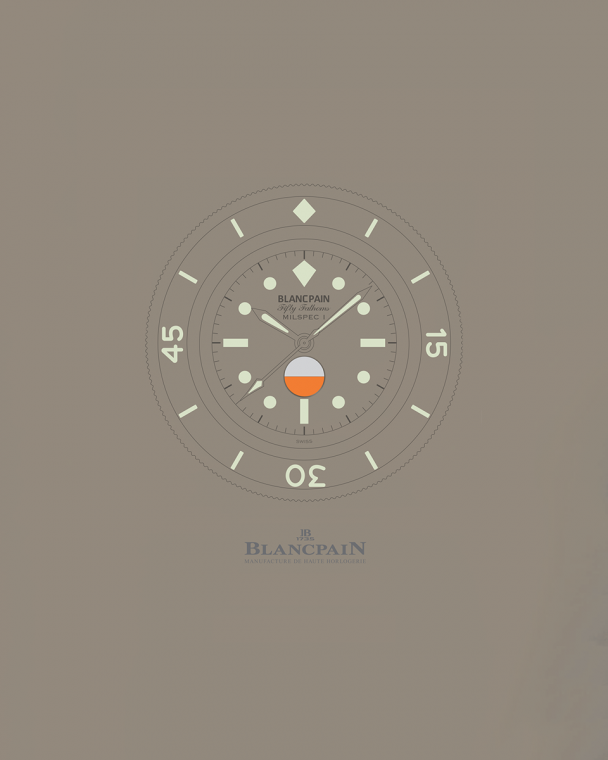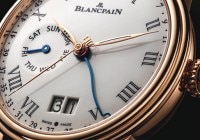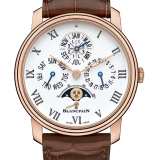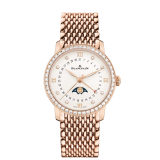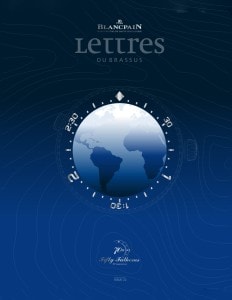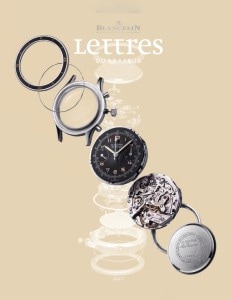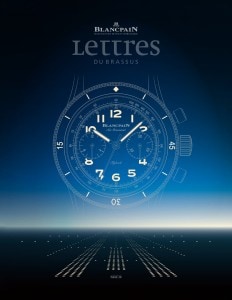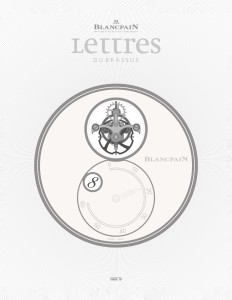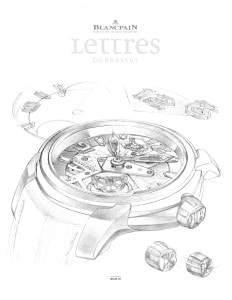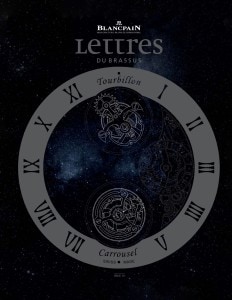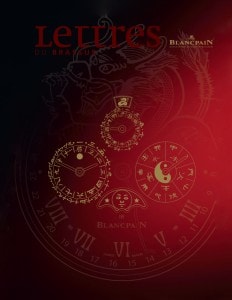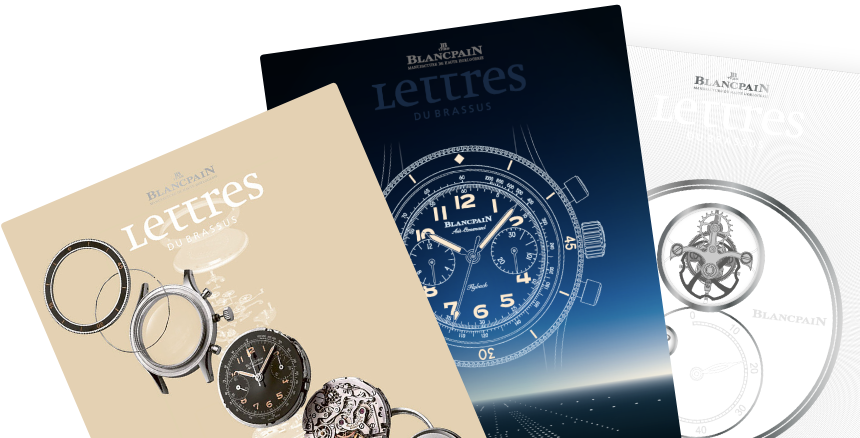
Search in Issues
Chapters
List of parts
Chapter 7
New Calendars
Three new calendar models, each with a different interpretation of the date.

A case can be made that of all the watchmaking complications THE DATE functions are the ones USED MOST OFTEN.
Reflect on this for a moment: of all the watchmaking complications, which is used the most frequently? Not to denigrate in the slightest, but certainly not alarms (after all we only wake up once a day, maybe twice if you have the luxury of an afternoon nap); not chronographs (unless you are devoted to timing risottos all day long, 16 minutes please); not repeaters (unlikely to sound their enchanting chimes more than a few times a day); not GMTs (certainly one is not traversing time zones every day). A case can be made that more than any other complication it would be the date function which is used the most often.
Recognizing the usefulness and importance of date complications, Blancpain debuted at Baselworld 2017 three timepieces within the Villeret collection offering different variations on the date theme: the Villeret Jour Date, Villeret Semainier Grande Date 8 Jours, and Villeret Quantième Phases de Lune. Taken together these offer three different “flavors” for the display of the date: a window, a large date, and a date hand.
Window: The Villeret collection is Blancpain’s most traditional with aesthetics that embody timeless elegance and refinement. The new Jour Date model reflects those values and marries the Villeret signature design elements of a double pomme bezel, Roman numerals and slim case profile with an understated display of the day of the week and date aligned next to each other at 3 o’clock. The presentation of the day and date integrates perfectly with the layout of the dial, fully preserving the harmony of the indexes and the small seconds, while at the same time offering easy legibility. The midnight change of the day of the week is instantaneous; the date semi-instantaneous. So as not to disturb the finely finished sides of the case with correctors, both the day and date are set and adjusted via the crown.
The movement powering the Jour Date watch is Blancpain’s automatic winding in-house caliber 1160 DD. With its two mainspring barrels, the 1160 DD achieves a 72-hour power reserve. In common with the movements across all its collections, Blancpain has fitted the 1160 DD with a free sprung balance with inertial regulation and a silicium balance spring. This combination greatly enhances not only the precision of the movement, but its robustness as well. Finely finished in the Villeret style with anglage, perlage, and côtes de Genève finishes, the movement, together with its yellow gold honeycomb guilloché pattern winding rotor, are on display through the clear case back. The Jour Date model features a 40 mm stainless steel case.
The ULTIMATE IN LEGIBILITY is the LARGE DATE complication.
Large Date: The Villeret Semainier Grande Date 8 Jours offers an entirely different interpretation of date functionality starting with the date itself. The ultimate in legibility is the large date complication. Placed at the 6 o’clock position, the date with its extra-large numerals is shown in two adjacent windows.
Like other Blancpain large date implementations, the Semainier’s date changes instantaneously at midnight.
In addition to its large date display, the Semainier offers two additional date complications. First, of course, is the one that has given its name to the timepiece:
a week of year indication with a serpentine hand.
Serpentine hands draw upon two centuries of watchmaking tradition. They were developed historically in order to facilitate the distinction between hands showing the time and those used for a supplementary indication. That is exactly the rationale behind Blancpain’s use of a serpentine hand for the Semainier. The large hands for the time display, hours, minutes and large seconds are in red gold with the hours and minutes subtly openworked in the Villeret style. As the large week of year hand is both blued and serpentine in shape, there is no possibility of confusion between it and the time display hands. The weeks of the year are arrayed on the perimeter of the dial outside of the Roman numerals.
Sharp-eyed connoisseurs will immediately notice that 53 weeks are shown on the Semainier’s dial. It is a common mistake made by many, including, lamentably, some other watch houses, to assume that there are always 52 weeks in a year. In fact, many years have 53 weeks. A bit of a technical briefing. The International Organization for Standardization, commonly known as “ISO”, has actually promulgated a standard, ISO 8601, for numbering weeks. According to the standard, week one of the year is the first week in January with a Thursday and closest to January 1. The last week of the year is one with a majority of its days falling in December and its last day is the Sunday falling closest to December 31. Applying these definitions from the standard shows that in every 400-year cycle of the Gregorian calendar, which we all follow, there are 71 years that have 53 weeks, or roughly one in five. Examples are 2012, 2017, 2023, 2028, 2034.
The Semainier has one additional date-related indication, the day of the week. This is displayed in a subdial at the 9 o’clock position.
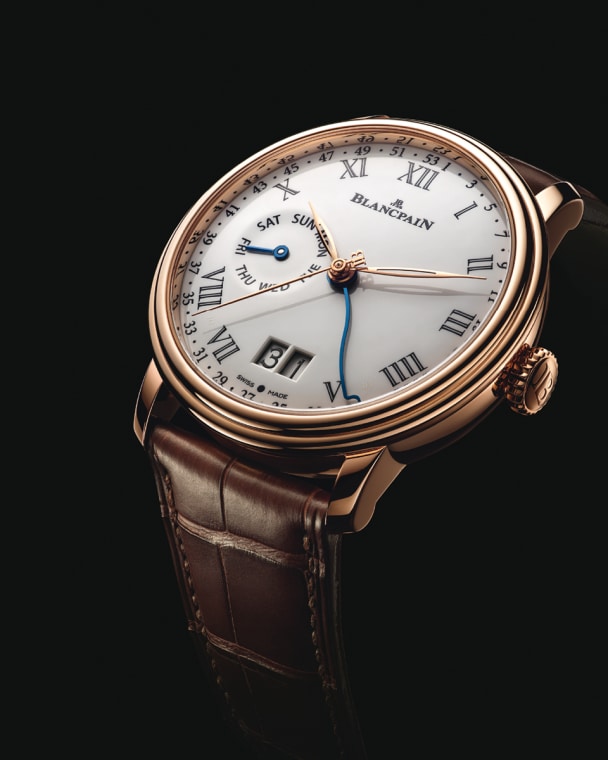
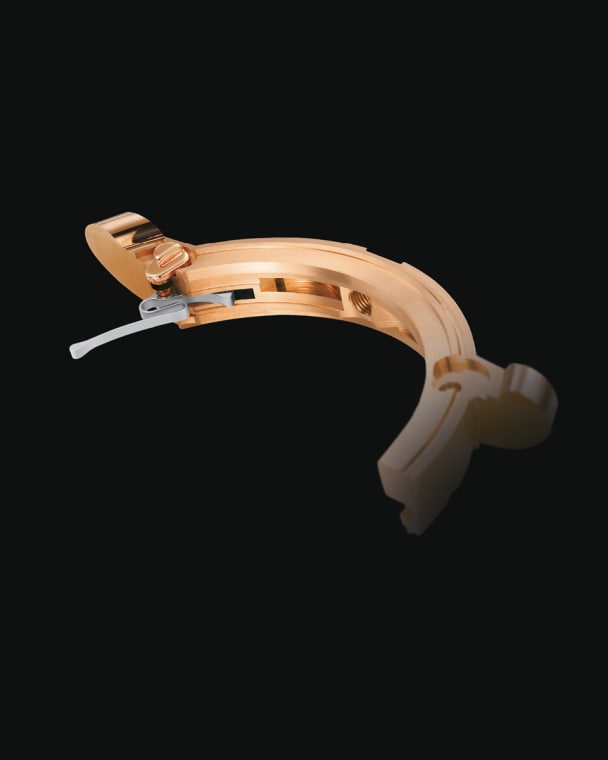
The construction of Blancpain’s patented under-lug correctors. Unlike the industry standard correctors placed on the flanks of the case, Blancpain’s design dispenses with the need for a pusher tool. Instead the under-lug tab can be actuated with a fingertip. A further bonus: since the correctors are nestled under the lugs, the flanks of the case are clean, unblemished by corrector dimples.
In addition to its large date display the Semainier offers WEEK OF YEAR and DAY OF THE WEEK indications.
Setting of all the calendar indications of the Semainier is accomplished by Blancpain’s exclusive and patented under-lug correctors. Most commonly, calendar indications are set using correctors, which appear as small dimples built into the sides of the case. These require a small tool or stylus in order to set or adjust the indication. Blancpain’s under-lug correctors dispense with both of these disadvantageous characteristics. Rather than blemishing the sides of the case with dimples, the correctors are hidden under the lugs of the watch, leaving the side profiles of the timepiece utterly clean. Beyond the enhancement of the appearance of the timepiece is the ease of use. Instead of requiring a stylus tool to actuate the corrector, Blancpain’s system allows setting and adjustment with a fingertip. The corrector under the 11 o’clock lug adjusts the day of the week; another corrector under the 1 o’clock lug sets the week of the year. The date is adjusted via the crown.
The movement of the Semainier is Blancpain’s in-house caliber 3738G2. This automatic winding movement achieves an extraordinary eight-day power reserve thanks to its three mainspring barrels. In common with the Jour Date model, the movement has been equipped with a free sprung inertially regulated balance wheel fitted with a silicium balance spring. In addition, the balance wheel has been crafted in titanium, which is the subject of another patent. The bi-color winding rotor has been decorated in a honeycomb guilloché pattern.
Bringing a special allure to all of these calendar indications is the Semainier’s full fired enamel dial. The process to create the dial is particularly demanding. Layer after layer of enamel are applied with oven firing accompanying each application. The end result justifies the effort as there is an added dimension of depth and richness which only full fired enamel can achieve.
The ensemble is fitted into a 42 mm red gold case and includes a hand stitched alligator strap with a red gold deployant buckle.
The STYLE of the date for the women’s Villeret Quantième Phases de Lune IS EMBLEMATIC FOR BLANCPAIN.
Date hand: With the women’s Villeret Quantième Phases de Lune, which is offered in both red gold and stainless steel models, Blancpain presents a third variation in the manner of its display of the date.
Thirty-one indexes are arrayed in a circle placed just inside the diamond indexes of the chapter ring. The date itself is marked by its own red-tipped hand. This style of date display is emblematic for Blancpain as it was used for the complete calendar moon phase timepiece which was the debut model in the early 1980s and has been featured in both the men’s and women’s collections continuously ever since. The moon phase is placed at 6 o’clock, distinguished from the men’s models by the image of the “man in the moon”, which in this case is a “woman in the moon” with a discreet beauty mark on her cheek.
Two of the stainless steel versions reprise an innovation which traces its roots back half a century to Blancpain’s Ladybird patrimony. The Ladybird, which debuted in 1956, pioneered an interchangeable strap system. As the strap threaded through a slot in the back of the watch, women could easily and quickly select color and style to suit mood and dress. The same spirit is found with the new women’s model. However, instead of threading the strap options though the back of the watch, which would result in a thicker profile, Blancpain developed a simple system with a miniature tab incorporated into the spring bar which holds the strap in place on the watch. Pulling the small tab with a finger releases the strap from the lugs. To insert a different strap reverses the process. Pulling on the tab allows a different colored strap to snap neatly into place on the watch.
The steel version of this new Villeret Quantième Phases de Lune IS PACKAGED AS AN ENSEMBLE.
With a no-fuss method for changing the strap, the Villeret Quantième Phases de Lune is packaged as an ensemble. Nestled into its wood presentation case is the timepiece with an array of five different straps, each conveying a different mood when mounted on the watch: three alligator straps in blue, red and black, along with white ostrich leather and black satin variations. There are four different versions of the new steel women’s timepiece: two with the interchangeable strap system, one with and one without diamonds set into the bezel and on the dial; two without the new strap system, again with or without diamonds on the bezel and dial.
The new Villeret Quantième Phases de Lune is fitted with Blancpain’s in-house caliber 913 which debuted in 2015. Blancpain fervently believes that the technical excellence of its women’s and men’s movements should be equal. Thus, the 913 features a free sprung balance and silicium balance spring. It also plows new technical ground in that the movement designers integrated the automatic winding system into the body of the movement instead of adding a separate winding bridge. (For more details see Issue No. 17 of Lettres du Brassus.)
Three Baselworld debuts and three distinctive interpretations of the all-important display of the date. •
|
PUBLISHER EDITORIAL COMMITTEE PROJECT MANAGEMENT EDITORS IN CHIEF CONTRIBUTORS TO THIS ISSUE TRANSLATION PROOFREADING |
GRAPHIC DESIGN. LAYOUT ART DIRECTION PHOTOLITHOGRAPHY WATCH PHOTOGRAPHY OTHER PHOTOGRAPHY, ILLUSTRATIONS
Release date: February 2018 |
